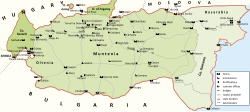Principality of Wallachia
| Principality of Wallachia | ||||||||||
| Цѣра Рȣмѫнѣскъ | ||||||||||
| Vassal of the Ottoman Empire (1417–1859) (under Russian protection 1774–1856) |
||||||||||
|
||||||||||
|
||||||||||
|
Wallachia in the late 14th century
|
||||||||||
| Capital |
Câmpulung, Curtea de Argeș (1330–1418) Târgoviște (1418–1659) Bucharest (from 1659) |
|||||||||
| Languages | Romanian (Old Romanian), Old Church Slavonic (in early official use) | |||||||||
| Religion | Eastern Orthodox | |||||||||
| Government | Absolute monarchy | |||||||||
| Prince | ||||||||||
| • | c. 1290 – c. 1310 | Radu Negru (first) | ||||||||
| • | 1859–62 | Alexandru Ioan Cuza (last) | ||||||||
| History | ||||||||||
| • | First official attestation | 1330 | ||||||||
| • | Traditional date Independence | 1290 | ||||||||
| • | Ottoman suzerainty | 1417 | ||||||||
| • | Long and Moldavian Magnate wars | 1593–1621 | ||||||||
| • | Treaties: • Küçük Kaynarca • Edirne |
21 July [O.S. 10 July] 1774 14 September [O.S. 2 September] 1829 |
||||||||
| • | Regulamentul Organic | 1834–1835 | ||||||||
| • | Union with Moldavia | 5 February [O.S. 24 January] 1859 | ||||||||
|
||||||||||
Wallachia or Walachia (Romanian: Țara Românească pronounced [ˈt͡sara romɨˈne̯askə]; archaic: Țeara Rumânească, Romanian Cyrillic alphabet: Цѣра Румѫнѣскъ) is a historical and geographical region of Romania. It is situated north of the Lower Danube and south of the Southern Carpathians. Wallachia is traditionally divided into two sections, Muntenia (Greater Wallachia) and Oltenia (Lesser Wallachia). Wallachia as a whole is sometimes referred to as Muntenia through identification with the larger of the two traditional sections.
Wallachia was founded as a principality in the early 14th century by Basarab I, after a rebellion against Charles I of Hungary, although the first mention of the territory of Wallachia west of the river Olt dates to a charter given to the voivode Seneslau in 1246 by Béla IV of Hungary. In 1417, Wallachia accepted the suzerainty of the Ottoman Empire; this lasted until the 19th century, albeit with brief periods of Russian occupation between 1768 and 1854. In 1859, Wallachia united with Moldavia to form the United Principalities, which adopted the name Romania in 1866 and officially became the Kingdom of Romania in 1881. Later, following the dissolution of the Austro-Hungarian Empire and the resolution of the elected representatives of Romanians in 1918, Bukovina, Transylvania and parts of Banat, Crișana and Maramureș were allocated to the Kingdom of Romania, forming the modern Romanian state.
...
Wikipedia



